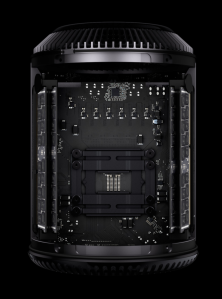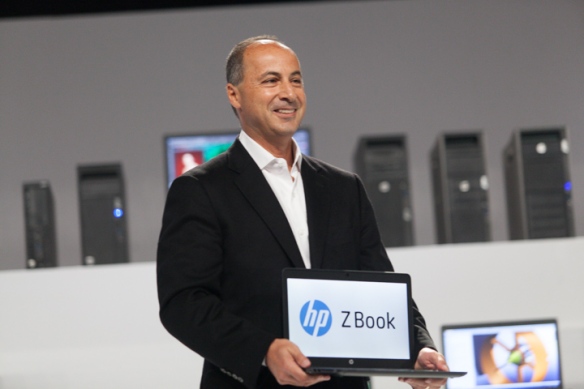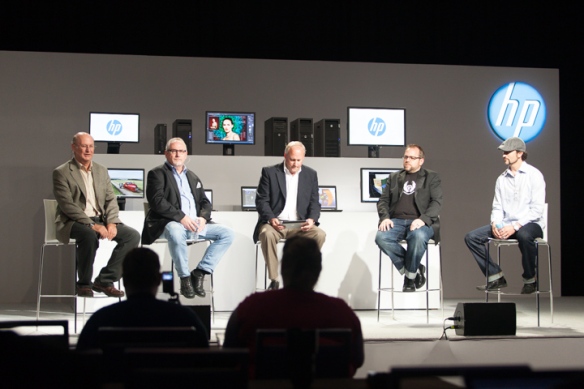OK,
Now that everyone you know has chimed in on the New MacPro, lets take a breath and look at reality, if you have been following Apple for any time at all, you know that they rarely if ever do what people think they will do.
Apple hardware has consistently gotten more unified, compact, and more refined. The iPhone has become a standard for all handsets, the Macbook Air stole the netbook market right out from underneath the PC world, then Apple finished it’s assault on the low end PC market by releasing the iPad, and even more than with the iPhone changed how we interface with devices, for the tablet was born and my computing was changed forever.

Apple’s sleek design
once more alienates.
Yes this is a radical departure from the existing product design, however some of the most Iconic of Apple’s hardware designs, The Cube, LUXO, the Candy Colored IMacs as well as the 20th Anniversary model all gave users iconic design, why does this Tube scare everyone so?
Because its different? Is that not what Apple has been about for a very long time? Get over it.
The New MacPro offers some stunning specs, albeit in a new way. Look Apple once again defined how users will interact with hardware, if you did not seem it wise to start embracing Thunderbolt, with this new MacPro, it is abundantly clear that it is and will be the future of device connectivity, with PC companies like HP fully behind Thunderbolt, the TB2 specs on this box ( Ok TUBE) blow me out the of the water.
The 6 fully independent 20Gbps Thunderbolt v2 ports can maintain an aggregate data rate of 15 Gigabytes per second. PERIOD!!!
Those TB2 ports can handle up to 36 peripheral devices, that can include storage, I/O to Firewire, Fibre or 10gE or SAS externally and the “3-4K Displays” Apple has been touting in the marketing

Inline storage module
on the new MacPro
Memory Questions: The internal storage is defined as PCIe Flash, now for the unknowing, this is by a wide margin the fastest possible. This is accessing your main storage at the speed of a RAM disk. One interesting thing to note in the Apple approved photos is that they are only showing 1 storage module.
The funny thing I see is that both of those fixed AMD graphics cards appear to have a place to allow for a second PCIe Flash module. I am wondering about the price and volumes for that storage, today it’s very expensive. Current PCIe Flash storage is available from companies like Fusion Io and even online retailers like Other World Computing and it’s fairly expensive for all but power users. My guess is that since Apple is changing the marketplace once again, the cost for PCIe Flash modules will reduce as the demand increases.

Note the place for the inline PCIeFlash module in the middle of the right side Graphics card and space for the same type of module on the left is mysteriously open. When did Apple ever leave wasted space in a machine this compact
What’s Possible
One other thing to note is the mysteriously missing PCIe memory module that could / should be in the same location on the left side graphics card in all of the Apple PR images.
From personal experience there is never a lot of free space to waste internally on an Apple device I have opened in the last few years, so I am wondering if that “open space” might be useable as part of the yet unannounced “Build-To-Order possibilities?
The Form Factor Matters
I am stunned by the small size, because at roughly 10″x 7″ this thing small, geez 8 of them fit in the same space as the previous tower form factor, I am just not comfortable with a rolly-poly, tube shaped computer when a good deal of my workstation level projects happen onset or on the road and that cylindrical shape is fraught with desperation for anyone needed to physically mount the machine for portability. Rack mounted computers have become the norm for DIT’s and Loaders, yet the new form factor does nothing to solve issues for that specific market.
Cuda vs OpenCL
The Open CL vs Cuda debate is a separate issue to me completely. Adobe’s backbone based in the Nvidia’s “Cuda” processes is only a minor advantage over the current OpenCL code being utilized for Apple processors, now if we can add Nvidia back into the mix as part of the BTO options, this might actually keep many of those power users from finally jumping off the MacPro wagon and onto an HP workstation.
I for one am keeping my HP Z800 right where it’s at, it’s the most powerful workhorse in my office and offers me power and performance unrivaled. That does not mean I am giving up my Mac’s. It means I have to live in a performance based world and much like with my retina laptop, it may take a little time to get the New MacPro and all of the associated peripherals to make it out to be the workstation it wants to be.

Finally.
This machine can’t possible be anything more for most user, It will have the fastest internal architecture possible, the fastest external connectivity and a lot of it, while the user configurable options will be more limited that in the past, the future upgradability is undeniable. Lost in the design debate so far is that most “power” users never add or remove parts from their MacPro’s once they are configured, the only difference with the new Apple is they want to control that at the manufacturing stage for the highest quality possible.
Apple has once again broken new ground, even if I don’t initially like what it looks like. I am thinking I will start a new biz doing skins for the New MacPro.












You must be logged in to post a comment.